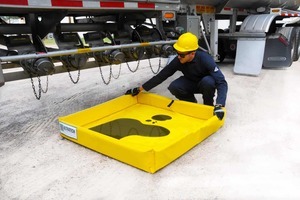Spill Response in Alberta’s Oilfields
July 23rd 2025

In Alberta’s oilfields, spills are more than a hypothetical risk—they’re part of the reality of daily operations. Whether you're working a lease road near Drayton Valley, fueling up equipment outside Cold Lake, or hauling fluids between Grande Prairie and Fox Creek, there’s always the potential for something to go wrong: a ruptured line, an overfilled tank, or a cracked valve during a deep freeze.
And when it does, there's no time to wait around for help to arrive. That’s why having the right spill kits and response supplies on-site is critical to minimize impact and ensure compliance.
How Spill Response Works in Alberta’s Oil & Gas Sector
In Alberta, spill response isn’t handled by a centralized government agency. Instead, it’s tightly regulated—and the responsibility falls squarely on the operator, contractor, or site manager.
Oilfield spills fall under the jurisdiction of the Alberta Energy Regulator (AER),which oversees all upstream oil and gas activity in the province. Broader environmental oversight comes from Alberta Environment and Protected Areas (AEPA). Both agencies enforce Alberta’s Environmental Protection and Enhancement Act (EPEA),which requires that any release of a substance that could harm the environment must be contained, reported, and cleaned up—immediately and at the operator’s expense.
That means whether you're running a small service rig or managing a SAGD site, you're not just responsible for day-to-day operations. You're also your site's first responder.
When a Spill Happens, You're the First Line of Defense
When a spill occurs, the clock starts ticking. Unlike on BC’s coast, where a federally certified response agency like WCMRC might deploy to a marine spill, Alberta’s system works differently. There is no equivalent agency coming to clean it up for you. If you need help, it’s up to you to hire a private contractor—and in many oilfield regions, that help could be several hours away.
Whether you're near Wabasca, Peace River, or Conklin, isolation is part of the job. That’s why your crews need to be trained, equipped, and ready to take immediate action.
If there’s a risk to the environment, you must report the incident to the province:
- Alberta EDGE (Environmental and Dangerous Goods Emergencies)
- 1-800-222-6514 — available 24/7
But keep in mind: this line triggers regulatory oversight, not cleanup support. The response is yours to manage.
Why Spill Kits Matter in the Patch
In Alberta's oilfields, the combination of extreme weather, remote locations, and hazardous materials means that even a small spill can escalate quickly. Fuel transfer stations, hydraulic lines, maintenance yards, and chemical storage areas are all high-risk zones.
Cold temperatures add another layer of difficulty. Absorbents and tools must work in sub-zero conditions, and equipment has to be tough enough to withstand daily use in rough terrain.
That’s why having well-placed, purpose-built spill kits isn’t optional—it’s essential.
What a Proper Oilfield Spill Kit Should Include
A spill kit is only as good as the gear inside it. Here’s what we recommend for oilfield operations:
- Oil-only absorbents (pads, rolls) – repel water and soak up diesel, lubricants, and hydraulic fluids
- Socks and booms – to contain spread on gravel, snow, or compacted soil
- Granular absorbents – for uneven terrain or areas with runoff risk
- Cold-rated PPE – gloves, goggles, and coveralls that won’t crack in winter
- Leak control tools – mini-berm containment trays, plugs, Plug n’ Dike repair putty, drain covers
- Disposal bags and ties – for quick, compliant cleanup
- Instructions and emergency labels – because not everyone on-site may be trained
These kits should be tailored to your operation—what works for a fluid truck in Lloydminster may not be right for a compressor station near Hinton.
Where to Place Spill Kits on Your Site (or in Your Fleet)
Being “equipped” means nothing if your kit is buried in the wrong building or sitting in a supervisor’s office 300 metres away. You need kits located where your teams actually work.
Ideal placement areas include:
- At fuel transfer stations or diesel tanks
- Inside mechanic trucks, fluid haulers, or hot shot vehicles
- Near wellheads, chemical sheds, and shop bays
- On service trailers or portable storage units
- In every truck cab traveling to or from remote sites
If your operation runs across Hwy 63, Hwy 43, or into the boreal regions north of Fort McMurray, mobile response capability isn’t a luxury—it’s a necessity.
Built for Alberta: Spill Kits That Work in the Real World
West Coast Spill Supplies offers spill kits specifically designed for the challenges of Alberta’s oilfields. We understand the terrain, the weather, and the equipment—and we build our kits with that in mind.
From rugged, cold-compatible materials to portable solutions for field crews, our gear is tested in the same environments you work in. Whether you're fueling up in Grande Prairie, operating SAGD in Cold Lake, or servicing wells outside Drayton Valley, our team can help match the right kit to your job.
Explore Our Oilfield-Ready Spill Kits
Be Ready Before It Happens
Spills don’t wait for convenient timing, good weather, or nearby support. In Alberta’s oilfields, you are the spill response team, and what you do in the first few minutes matters more than anything that happens after.
If you’re unsure what type of kit you need—or want to ensure your site or fleet is properly equipped—we can help.
Let’s make sure your team is ready, your site is protected, and your response is faster than the damage.
Contact Us for Custom Oilfield Spill Response Kits
